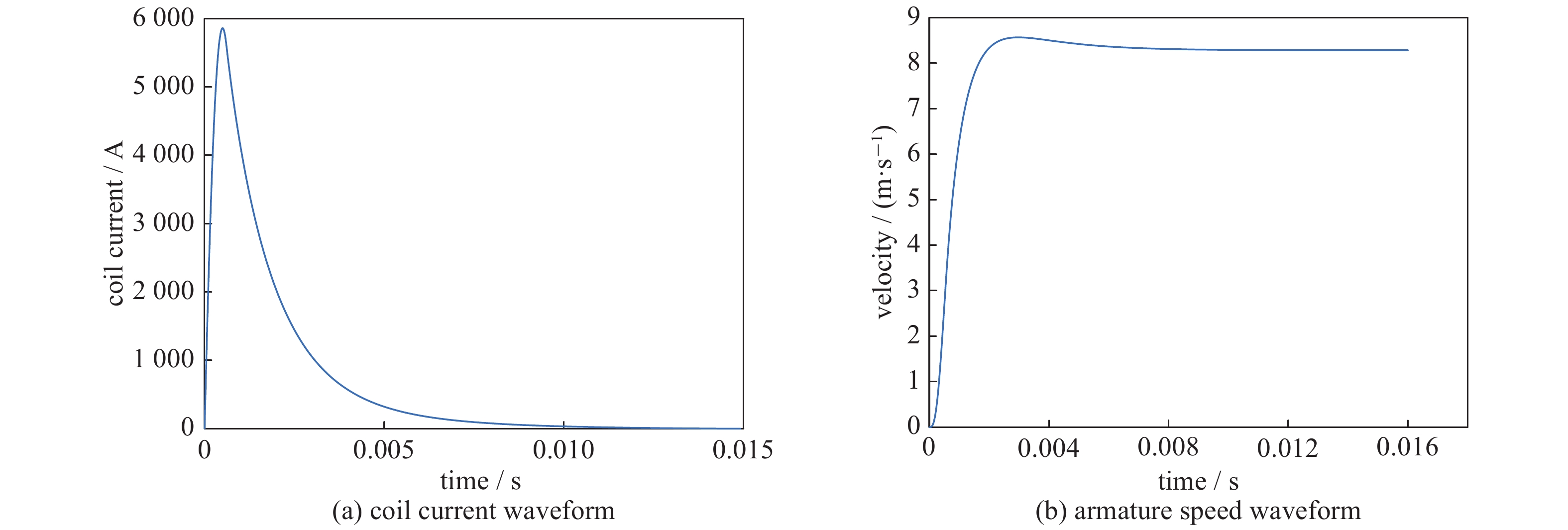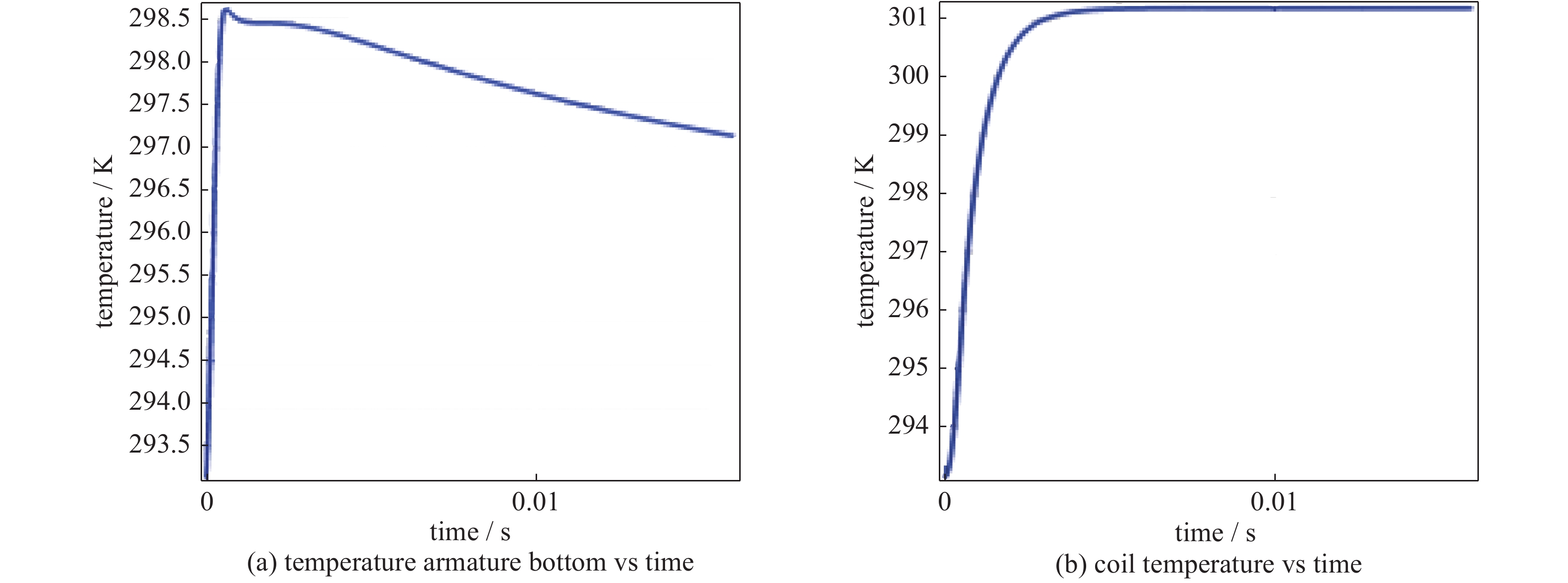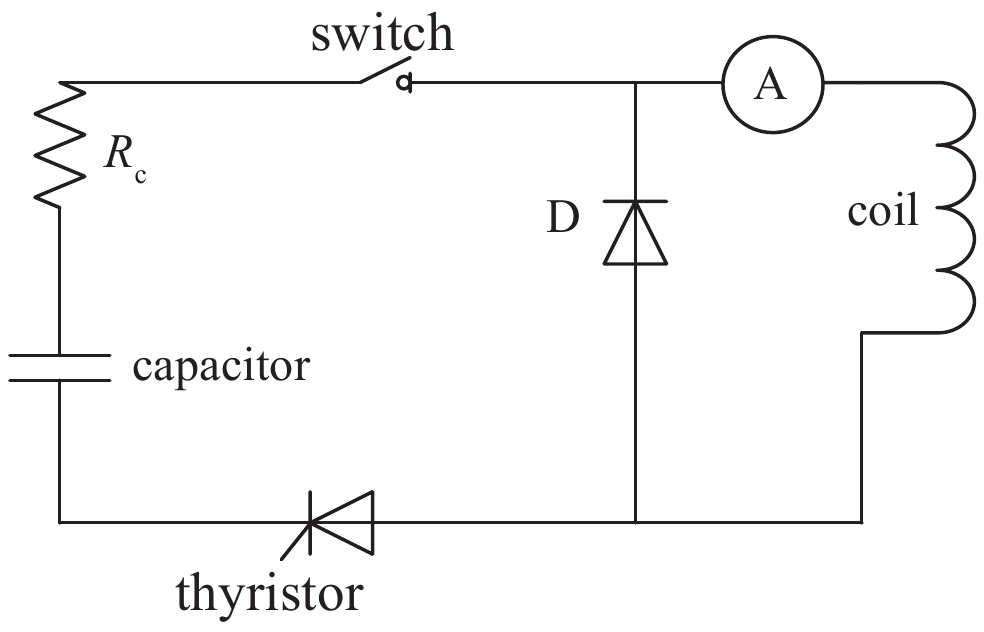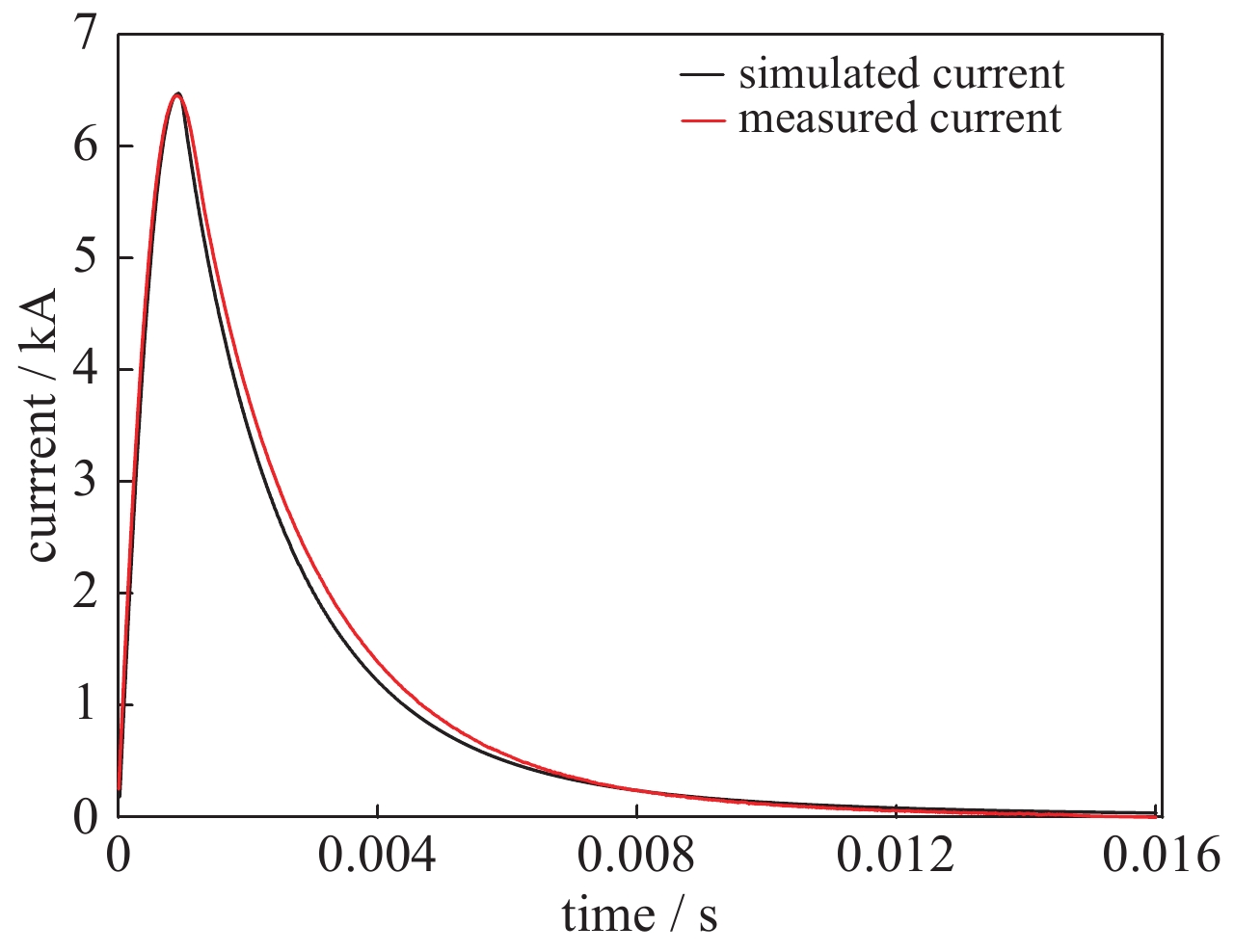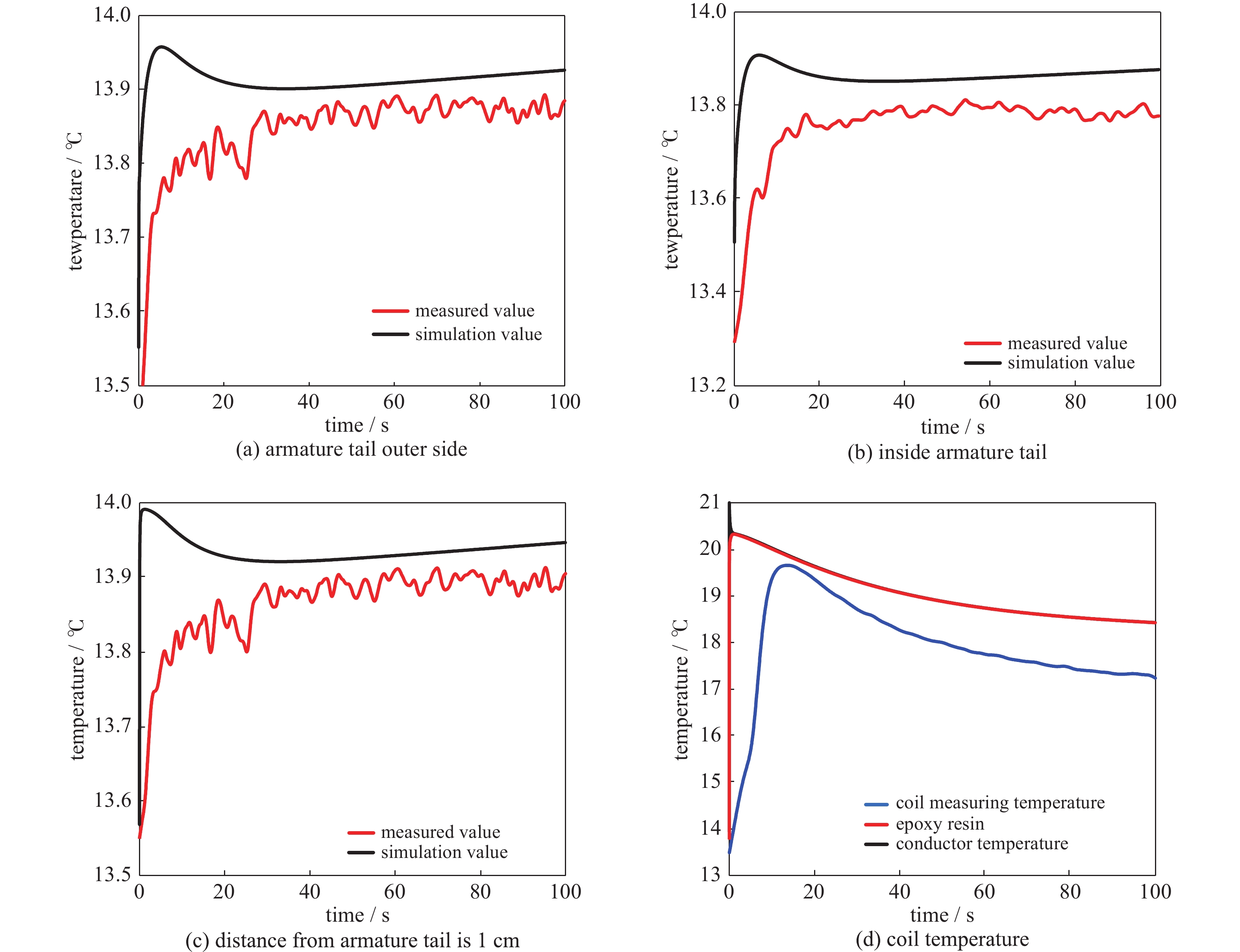Study on temperature rise of electromagnetic coil launcher
-
摘要: 同步感应式线圈型电磁发射器主要采用脉冲电流对线圈直接供电,其实际工作过程中电枢和线圈会产生温升,这是当前制约线圈发射器向小型化、高速发展的一个主要因素。本文通过建立电磁线圈的温升模型,对于单次触发的情况,分别利用Comsol和自编程序Coilgun进行计算,并搭建相应的试验平台进行验证。采用直接耦合方式的Comsol计算结果最为准确,也能考虑材料参数随温度的变化。仿真得到电枢的温升大约为4.2 ℃,线圈最大温升为7.7 ℃。由于热电偶温度传感器的测量延迟性与采样频率的限制,电枢温度试验曲线未能测量到仿真曲线中出现的温度最大值点,可记录到整个试验过程中温度变化曲线,其变化形势以及最终稳定的温度与仿真的基本一致,误差最大为6.1%,说明了仿真的准确性。为后续进行多级线圈连续发射奠定基础。Abstract: Synchronous induction coil launcher mainly uses pulse current to supply power directly to the coil. The temperature rise of armature and coil will occur in the actual working process, and it is a major factor restricting the development of coil launcher to miniaturization and high speed. In this paper, the temperature rise model of electromagnetic coil is established. For single trigger, Comsol and self-programmed Coilgun are used to calculate, and the corresponding test platform is built to verify the temperature rise. The Comsol method with direct coupling is the most accurate method, and the change of material parameters with temperature can also be considered. The simulation results show that the temperature rise of armature is about 4.2 ℃ and the maximum temperature rise of coil is 7.7 ℃. Because of the limitation of measurement delay and sampling frequency of thermocouple temperature sensor, the armature temperature test curve can not measure the maximum temperature point in the simulation curve, it can record the temperature change curve in the whole test process. The change of temperature and the final stable temperature are basically consistent with that of the simulation. The maximum error is 6.1%, which shows the accuracy of the simulation. This study lays a foundation for subsequent multi-stage coil continuous launching.
-
表 1 电磁感应线圈发射器参数
Table 1. Electromagnetic induction coil launcher parameters
internal diameter/mm thickness/mm length/mm turns internal diameter/mm length/mm capacitance/mF voltage/V armature coil power supply 37.5 10 100 26 60 60 2 1 300 表 2 单级电磁感应线圈发射器结果对比
Table 2. Comparison of single stage electromagnetic induction coil transmitter results
method comsol multiphysical field simulation current wire model method outlet velocity/(m·s-1) 8.286 8.827 maximum speed/(m·s-1) 8.569 9.644 maximum coil temperature/℃(t=0.016 s) 28.03 28.29 armature maximum temperature/℃(t=0.016 s) 24.10 24.23 maximum coil temperature/℃(whole process) 28.05 28.29 armature maximum temperature/℃(whole process) 25.41 24.23 表 3 单级感应线圈发射器单次脉冲放电试验结果(t=100 s)
Table 3. Single pulse discharge test results of single-stage induction coil transmitter (t=100 s)
test temperature/℃ simulation temperature/℃ error/% armature tail outer side 13.85 13.926 0.55 inside armature tail 13.78 13.86 0.58 1 cm from armature tail 13.91 13.947 0.27 coil wire 17.25 18.38 6.1 -
[1] Sterling T L, Salmon J, Becker D J, et al. How to build a Beowulf[M]. Cambridge: MIT Press, 1999. [2] Wang Y, Marshall R. Physics of electric launch[M]. Beijing: Science Press, 2004: 11-19. [3] Quan K B, Zhen H X, Hongxing W, et al. Thrust and thermal characteristics of electromagnetic launcher based on permanent magnet linear synchronous motors[J]. IEEE Trans Magnetics, 2009, 45(1): 358-362. doi: 10.1109/TMAG.2008.2008883 [4] Engel T G, Nunnally W C, Gahl J M. High-efficiency helical coil electromagnetic 1auncher[R]. Columbia: University of Missouri, 2006. [5] Marder B. SLINGSHOT—A coilgun design code[R]. SAND2001-1780, 2001. [6] Zhang Y D, Ruan J, Wang Y, et al. Armature performance comparison of an induction coil launcher[J]. IEEE Trans Plasma Science, 2011, 39(1): 471-475. doi: 10.1109/TPS.2010.2049753 [7] 张朝伟, 邓启斌, 汤磊, 等. 同步感应线圈炮电枢特性分析[J]. 火炮发射与控制学报, 2011, 17(3):14-18. (Zhang Chaowei, Deng Qibin, Tang Lei, et al. Armature characteristic analysis of synchronous induction coil gun[J]. Journal of Artillery Launch and Control, 2011, 17(3): 14-18 doi: 10.3969/j.issn.1673-6524.2011.03.004 [8] Barmada S, Musolino A, Raugi M, et al. Analysis of the performance of a multi-stage pulsed linear induction launcher[J]. IEEE Trans Magnetics, 2001, 37(1): 111-115. doi: 10.1109/20.911802 [9] 牛小波, 刘开培, 张亚东, 等. 基于电流丝法的多级同步感应线圈炮电枢温升计算[J]. 强激光与粒子束, 2015, 27:095001. (Niu Xiaobo, Liu Kaipei, Zhang Yadong, et al. Armature temperature rise calculation of multi-stage synchronous induction coil gun based on current filament method[J]. High Power Laser and Particle Beams, 2015, 27: 095001 [10] Zhang T, Su Z, Guo W, et al. Research on the temperature field of multistage synchronous induction coilgun[J]. IEEE Transactions on Plasma Science, 2017, 45(7): 1295-1301. doi: 10.1109/TPS.2017.2705155 [11] 刘守豹, 阮江军, 杜志叶, 等. 感应线圈炮性能的场路结合分析[J]. 电工技术学报, 2010, 25(12):1-7. (Liu Shoubao, Ruan Jiangjun, Du Zhiye, et al. Field circuit analysis of induction coil gun performance[J]. Journal of electrical technology, 2010, 25(12): 1-7 [12] 刘守豹, 阮江军, 彭迎, 等. 改进电流丝法及其在感应线圈炮场路结合分析中的应用[J]. 中国电机工程学报, 2010, 30(30):128-134. (Liu Shoubao, Ruan Jiangjun, Peng Ying, et al. Improved current wire method and its application in the combination analysis of induction coil battery[J]. Chinese Journal of electrical engineering, 2010, 30(30): 128-134 -





 下载:
下载:


